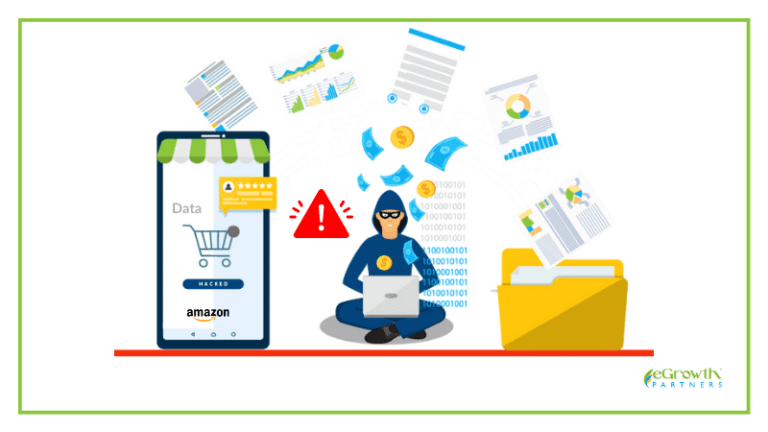In the last blog I looked at the fact that our Amazon seller (and consumer) data is vulnerable to exploitation by a wide range of bad actors. Part Two of this series looks at just what that data is. Amazon has a lot of data on both sellers and consumers – data for which bad actors will happily pay.
Amazon Seller Data is God-Like
Amazon’s data on its sellers is unbelievably detailed. I discovered this years ago when an Amazon employee accidentally copied to my client their seller data file. It goes far beyond sales and products. Amazon seemingly captures every keystroke you’ve ever made as a seller and as a buyer and every possible relationship on and off the platform. Amazon knows that you looked at 10 blenders before buying one, what the other ones were and how long you looked at each blender before moving on, how thoroughly you looked at the listing, what parts of the listing you looked at, for example.
On the seller side, Amazon knows if you are spending time on your competitor’s listings, if you bought a product and if you left a review. They know if you are using your Prime membership to buy products to resell on Amazon. They know if you’ve ever operated a seller account in the past and much more.
Sellers often ask me, “How does Amazon link accounts? How do they know about XYZ?” They know. I don’t always know how they know, but they know. I imagine it a bit like the Eye of Sauron: when they focus on you, there is no escape. Luckily, they aren’t looking all the time, but once you’ve committed a violation of their policies, you will start to get more and more notifications. The Eye is upon you. (Shout out to my JRR Tolkien peeps!)
Knowing that Amazon’s data is God-like and more thorough than you can imagine, you should be very concerned about it being available to your competitors. A bad actor knows more about your account than you do when they buy your data from a black hat dealer.
They know exactly how many units a day they must sell to out-rank you and to take the number one position. They know how many reviews will put their organic search results and paid ads ahead of yours on buyer’s screens. They know all your keywords and how well they are doing.
They know exactly how many consumers have your products in their wish lists or shopping cart. This is a significant piece of data that helps them steal rank and the “Amazon’s Choice” badge. They hire black hat service providers with tens of thousands of falsely “aged” accounts to add their product to a wish list and/or shopping cart. If you’ve ever wondered “how is that crappy product Amazon’s Choice?” now you know. The algorithm uses wish lists and shopping carts (among other factors) to judge a product’s popularity with consumers. It rewards “popular” products with the badge.
They also know how many reviews and sales they need to get a day to achieve and stay in the number 1 position. The tactic of “brushing” is so effective because a bad actor can use the high number of positive reviews for a defunct product to add hundreds to thousands of reviews to their listings every day, for example, through an improper variation. This is why you might see a review for a cat toy under a product listing for a blender, for example. It was deliberate and the bad actor knew exactly how many reviews they needed to get ahead of the competition.
Amazon’s algorithm is complex and takes in multiple factors to determine rank. Reviews are heavily weighted in this determination, which is why brands (black hat or otherwise) try so hard to increase their 5-star reviews. It can take years for an honest seller to gather a volume of reviews, but a newcomer can surpass them in a week.
Bad actors use bribes to manipulate so-called organic search as well. You know how you start typing something in the search bar and Amazon gives you auto-fill options? Those are supposed to rank and reflect actual buyer search terms. If a lot of people are typing in “Barbie car” right now, Amazon makes it easy to click after a few letters and it offers things like “Barbie Corvette” and “Barbie movie car.” Bad actors can change that, so their keywords are on top instead and the buyer’s click shows their ad and product ahead of the competition even if the buyer typed in a specific brand name. How much is that worth to a bad actor? Potentially millions.
Amazon Seller Bad Actors are Still on the Platform
Amazon took on these six co-conspirators to make a statement, among other things. They are well-known in the community, but they are not the only bad actors out there. I’ve seen no indication in our practice that seller-on-seller bad behavior has slowed down because these guys got caught. I did notice an abrupt cessation of bad actors replacing competitor product images with rude or improper images. Perhaps this was a particular Dirty Seller Trick© of this group.
Bad actors are still making changes to other sellers’ listings to get the listing taken down or to make the seller pay higher fees or generally just to spend a lot of time trying to keep their listings intact. Our clients have bad actors that keep changing the size of their packages (higher Amazon fees) or moving them into inappropriate categories (so they lose ranking and sales) or planting inappropriate keywords so the listing is suspended.
Most of the other dirty seller tricks are still going strong as well. Even if a tactic isn’t specifically against another seller, every seller who improperly gets into a restricted category or provides fake invoices to get out of an IP complaint is gaining an unfair advantage against other sellers and brands who play by the rules. Not only that, but the products sold by these cheaters could be shoddy, unsafe, stolen or counterfeit. After all, honest sellers with real invoices and a real relationship with the brand don’t need to forge documents.
Very few sellers who were clients of the co-conspirators have been suspended or banned by Amazon as of this writing. This means there are sellers who used their services to get reinstated or to get fraudulent reimbursements to get into categories that they couldn’t legitimately qualify for, to attack other sellers and more, who are still selling among us. Is this because Amazon doesn’t have access to the client lists? Certainly, the government has that information. They confiscated dozens of computers, drives, files, and phones from the co-conspirators.
While some of these sellers were getting account annotations to get themselves reinstated, others had much darker purposes. In the indictment, the government talked about “Client 1” and “Client 2” specifically. These companies paid large sums of money to get reinstated because they were banned by Amazon. There was no way they could get back without bribery. That should give us all pause.
The fact that black hat data brokers are still freely advertising on Telegram and through LinkedIn (see the CNBC story for details) says there are a lot more bad actors aggressively attacking other sellers, manipulating reviews and more. Many other black hat services are also still in business with their huge server farms of fake Amazon accounts and manipulation tactics learned through the theft of trade secrets about Amazon’s algorithms.
Bad actors are a complicated problem. There is no one solution to it. Amazon tries to stop bad actors from getting on the platform in the first place through Seller Identity Verification (“verification”). See the next post in this series to learn why verification isn’t enough.





